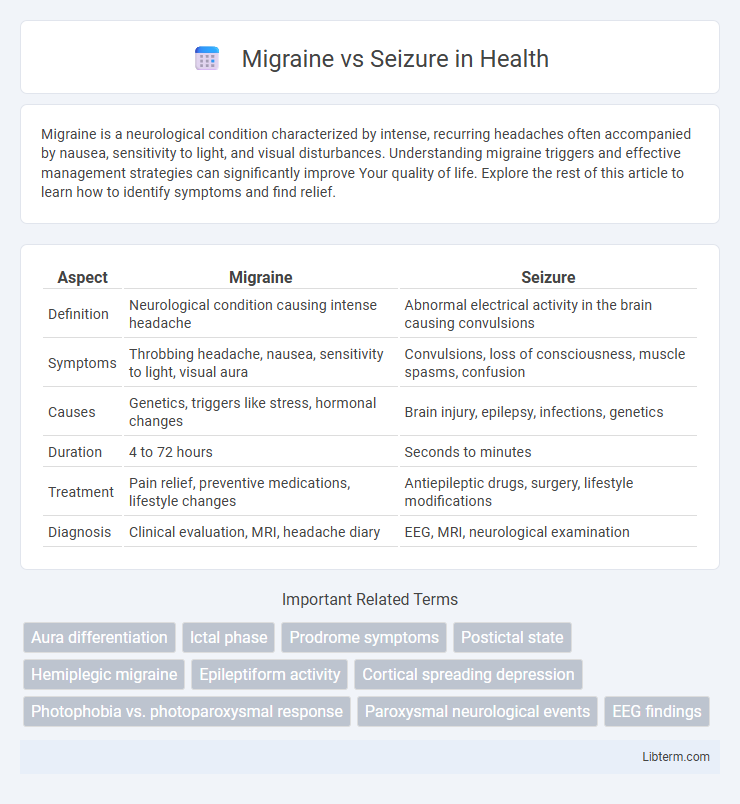Migraine is a neurological condition characterized by intense, recurring headaches often accompanied by nausea, sensitivity to light, and visual disturbances. Understanding migraine triggers and effective management strategies can significantly improve Your quality of life. Explore the rest of this article to learn how to identify symptoms and find relief.
Table of Comparison
| Aspect | Migraine | Seizure |
|---|---|---|
| Definition | Neurological condition causing intense headache | Abnormal electrical activity in the brain causing convulsions |
| Symptoms | Throbbing headache, nausea, sensitivity to light, visual aura | Convulsions, loss of consciousness, muscle spasms, confusion |
| Causes | Genetics, triggers like stress, hormonal changes | Brain injury, epilepsy, infections, genetics |
| Duration | 4 to 72 hours | Seconds to minutes |
| Treatment | Pain relief, preventive medications, lifestyle changes | Antiepileptic drugs, surgery, lifestyle modifications |
| Diagnosis | Clinical evaluation, MRI, headache diary | EEG, MRI, neurological examination |
Understanding Migraines: Definition and Symptoms
Migraines are a neurological disorder characterized by intense, throbbing headaches often accompanied by nausea, vomiting, and sensitivity to light or sound. Unlike seizures, migraines may present with an aura--visual disturbances like flashing lights or blind spots--that precede the headache phase. Recognizing migraine symptoms accurately aids in differentiating them from seizure episodes, which involve abnormal electrical brain activity and sudden, uncontrolled physical movements.
What Are Seizures? Key Characteristics
Seizures are sudden, uncontrolled electrical disturbances in the brain that can cause changes in behavior, movements, feelings, or consciousness. Key characteristics include convulsions, loss of awareness, and sensory abnormalities, often lasting seconds to minutes. Unlike migraines, seizures typically involve brief episodes of intense neurological activity, sometimes followed by confusion or fatigue.
Migraine vs Seizure: Main Differences
Migraine and seizure are distinct neurological disorders with different underlying mechanisms and symptoms. Migraines are characterized by throbbing headaches often accompanied by nausea, visual disturbances, and sensitivity to light and sound, while seizures involve sudden, uncontrolled electrical activity in the brain leading to convulsions, loss of consciousness, or sensory disruptions. Diagnosis relies on clinical history, neurological exams, and diagnostic tools such as EEG for seizures and imaging or migraine diaries for migraines.
Common Triggers for Migraines and Seizures
Common triggers for migraines include stress, hormonal changes, certain foods like aged cheeses and caffeine, sensory stimuli such as bright lights or loud sounds, and irregular sleep patterns. Seizure triggers often involve sleep deprivation, flashing lights, alcohol consumption, stress, and sudden changes in medication or missed doses. Identifying and managing these shared and distinct triggers is crucial for reducing the frequency and severity of migraines and seizures.
Diagnostic Methods: Migraine vs Seizure
Diagnostic methods for migraines primarily involve clinical evaluation using the International Classification of Headache Disorders (ICHD) criteria, along with patient history and symptom assessment. In contrast, seizures require electroencephalogram (EEG) tests, neuroimaging such as MRI or CT scans, and detailed neurological examinations to identify abnormal electrical activity in the brain. While migraine diagnosis relies heavily on symptom patterns and triggers, seizure diagnosis depends on objective evidence from EEG and imaging studies to differentiate between epileptic and non-epileptic events.
Overlapping Symptoms: How to Differentiate
Migraine and seizure share overlapping symptoms such as sensory disturbances, visual aura, and temporary neurological deficits, complicating diagnosis. Key differentiators include the duration and progression of symptoms: migraine aura typically lasts 20-60 minutes with gradual onset, while seizure symptoms are brief, lasting seconds to a few minutes with rapid onset and cessation. Diagnostic tools like EEG for seizures and detailed patient history for migraines support accurate differentiation and tailored treatment.
Treatment Options for Migraines
Migraine treatment options primarily include analgesics, triptans, and preventive medications such as beta-blockers, anticonvulsants, and CGRP inhibitors. Lifestyle modifications like stress management, regular sleep, and dietary adjustments significantly reduce migraine frequency and severity. Unlike seizures, which require anticonvulsant therapy, migraine treatments target neurovascular mechanisms and symptom-specific relief.
Treatment Options for Seizures
Treatment options for seizures primarily involve antiepileptic drugs (AEDs) such as levetiracetam, valproate, and carbamazepine, which aim to reduce the frequency and intensity of seizures. In refractory cases, surgical interventions like temporal lobe resection or neurostimulation therapies, including vagus nerve stimulation (VNS) and responsive neurostimulation (RNS), may be considered. Lifestyle modifications and avoidance of known seizure triggers are also integral to managing seizure disorders effectively.
When to Seek Medical Help
Seek medical help immediately if a migraine is accompanied by sudden vision loss, weakness, confusion, or difficulty speaking, as these symptoms may mimic a seizure or indicate a stroke. Seizures require urgent evaluation when they last more than five minutes, occur repeatedly without full recovery, or follow a head injury. Both conditions demand prompt medical attention if symptoms are new, severe, or worsen abruptly to prevent complications and ensure appropriate treatment.
Preventive Strategies for Both Conditions
Preventive strategies for migraines focus on lifestyle modifications such as regular sleep patterns, stress management, and avoiding known triggers like certain foods and environmental factors. Seizure prevention emphasizes adherence to antiepileptic medications, seizure trigger avoidance, and maintaining consistent sleep hygiene. Both conditions benefit from regular medical follow-up to tailor preventive treatments and monitor effectiveness.
Migraine Infographic

 libterm.com
libterm.com